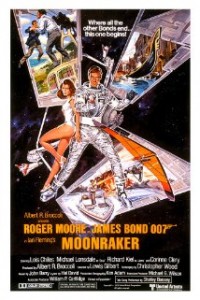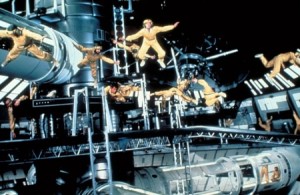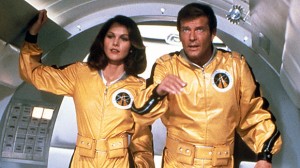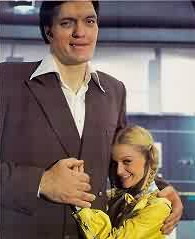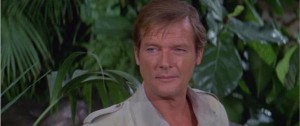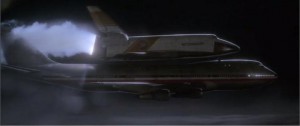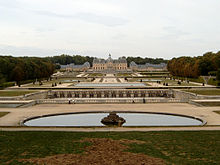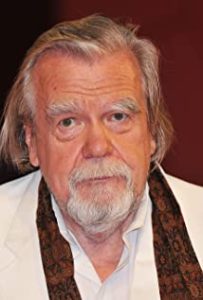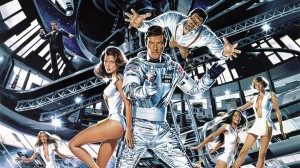Moonraker *** (1979, Roger Moore, Lois Chiles, Michael Lonsdale, Richard Kiel) – Classic Movie Review 952
Director Lewis Gilbert’s spoofy 1979 James Bond movie Moonraker is the fourth to star Roger Moore, this time on a mission to investigate the mid-air theft of a space shuttle. Strangely enough, he discovers that there is another arch-villain out to threaten civilisation as we know it, in a plot to commit global genocide.
This is number 11 in the 007 series – and luckily director Gilbert (helming his third and final Bond film) has a budget as big as the GNP of a small country to deploy on stunts, gadgets and mouth-watering Venice, Rio and Amazon locations. Controversially, the film was primarily shot in France, along with the locations in Italy, Brazil, Guatemala and the United States. And much of the film was shot in the cities of London, Paris, Venice, Palmdale, California, Port St Lucie, Florida, and Rio de Janeiro.
The sound stages of Pinewood Studios in England, traditionally used for the series, were only used by the special effects team. When they were splashing out money everywhere, this was a cost-cutting exercise, unpopular in the UK. Not the cost-cutting, the abandoning the UK.
Indeed it is notable for its the extremely high production cost of $34 million, almost twice as much as predecessor, The Spy Who Loved Me. Despite its cynically campy tone, the impressive visual effects and stunts and all the flashy space-age trappings to give it a veneer of sophistication, it still looks like a slightly creaky and weary, spying-by-the-numbers re-run of earlier, more distinguished adventures.
But there are good villains in Michael Lonsdale as the sinisterly suave Hugo Drax, judo expert Toshiro Suga as his henchman Chang and Richard Kiel, who is happily back as Jaws, after his huge success in The Spy Who Loved Me. The perfect henchman, Kiel is so memorable that he became the only recurring 007 villain to be played by the same actor. And there are good heroes in the usual old-style vintage team of Moore, Lois Maxwell (Miss Moneypenny) Bernard Lee (M) and Desmond Llewelyn (Q).
In an action highlight, Bond gets to fight with a giant anaconda in Drax’s Brazil subterranean launch-site pool. But the movie’s finest sequences come where they are most needed at the start and finish – the opening great free-fall fight and climax of the film with the laser-gun battle on Drax’s space station. Moonraker still holds the world record for the largest number of zero gravity wires in one scene.
Lois Chiles makes a particularly feisty Bond girl as NASA astronaut Dr Holly Goodhead (oh dear!). But The Story of O star Corinne Clery has a thankless task as the Bond beauty Corinne Dufour, as she is all too soon dispatched by Drax’s hounds after she reveals the secret location of his safe.
Writer Richard Maibaum said: ‘With Moonraker, we went too far in the outlandish. The audience did not believe any more and Roger spoofed too much.’ The scene in which Moore drives a hovercraft gondola around St Mark’s Square in Venice was widely criticised by film critics. Nevertheless, after premiering on 26 June 1979 in the UK, Moonraker grossed over $70 million here alone and went on to take $210,300,000 worldwide, becoming the highest grossing film of the series so far, a record that stood until 1995’s GoldenEye.
Christopher Wood’s screenplay is supposedly based on the novel by Ian Fleming. The titles are by Maurice Binder and the title song, with lyrics by Hal David, is sung by Shirley Bassey, but it didn’t turn out to be a classic. [Replacing Johnny Mathis at short notice, Bassey records her third Bond song after Goldfinger and Diamonds Are Forever.] The action unit directors are Ernest Day and John Glen, and the stunts are staged by Bob Simmons. Derek Meddings, Paul Wilson and John Evans were Oscar nominated for Best Visual Effects. Once again, Ken Adam is responsible for the eye-catching set designs.
The Château de Vaux-le-Vicomte was used for Drax’s chateau in the film. An extensive aerial view of the site was witnessed by helicopter in the early stages of the film by Bond and Dufour arriving.
Stuntman Richard Graydon slipped and narrowly avoided falling to his death during the filming of the cable car sequence at Sugarloaf Mountain.
The exaggerated nature of the plot and space station sequence has seen the film much parodied, notably in the Austin Powers spoof The Spy Who Shagged Me (1999) which refers to Moonraker in Dr Evil’s lair in space. The scene in which Drax is shot by the cyanide dart and ousted into space is parodied by Powers’s ejection of Dr Evil’s clone Mini-Me into outer space in the same way.
The 7’2 tall, Detroit-born actor Richard Kiel died on September 10 2014 at the age of 74.
RIP veteran actor Michael Lonsdale, who died on September 21, 2020 in Paris, aged 89. He was best known for The Day of the Jackal (1973), Moonraker (1979) and Ronin (1998).
http://derekwinnert.com/the-spy-who-loved-me-classic-film-review-405/
http://derekwinnert.com/austin-powers-the-spy-who-shagged-me-classic-film-review-492/
http://derekwinnert.com/goldfinger-classic-film-review-403/
© Derek Winnert 2014 Classic Movie Review 952 derekwinnert.com

